-
Countries
-
Data and Analysis
-
Special Focus
-
Crisis Responses
Situation Report
This report provides insights into the profiles, experiences, needs, routes travelled and intentions of migrants transiting through the Western Balkans.
IOM surveyed 1,033 migrants from 1 April to 30 April 2024 in Albania, Bosnia and Herzegovina, Montenegro, North Macedonia, Serbia and Kosovo*.
* References to Kosovo* shall be understood in the context of UN Security Council Resolution 1244 (1999).
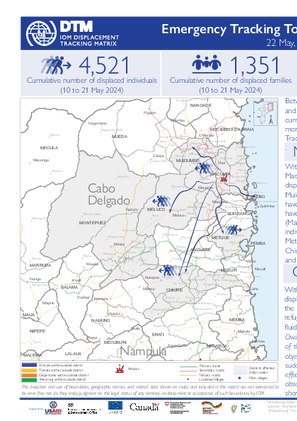
Contact
DTMMozambique@iom.int
Language
English
Location
Mozambique
Period Covered
May 10 2024
May 21 2024
Activity
- Mobility Tracking
- Event Tracking
Between 10 to 21 May 2024, attacks, and fear of attacks by Non-state Armed Groups in Macomia and Quissanga triggered the cumulative displacement of 4,521 individuals/ 1,351 families. The current Movement Alert #114 reports on most recent attacks in Northen Cabo Delgado. For more information on displacements between January and April, please see {Emergency Tracking Online Dashboard}.
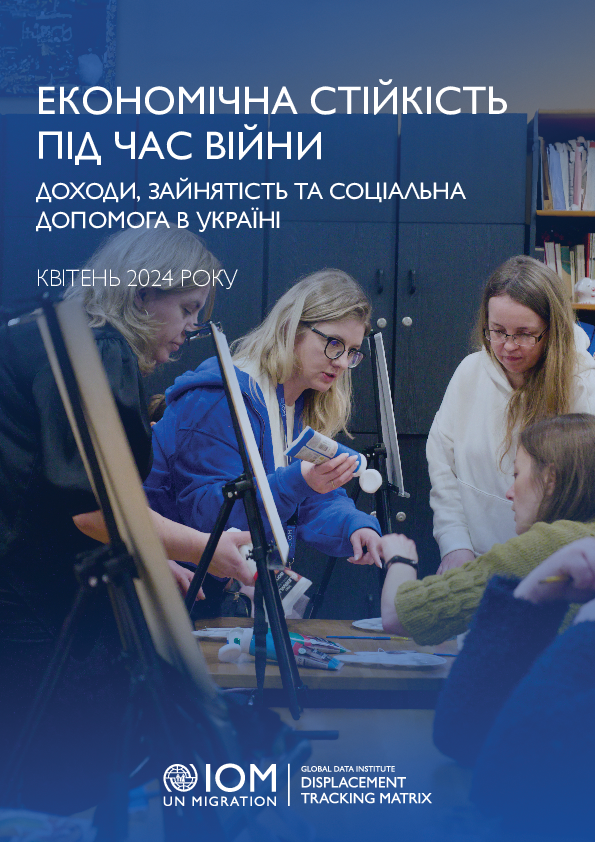
Contact
DTM Ukraine, dtmukraine@iom.int
Language
English
Location
Ukraine
Snapshot Date
Apr 30 2024
Activity
- Other
Після повномасштабного вторгнення в Україну в лютому 2022 року країна зіткнулася з глибокими економічними потрясіннями та масовим переміщенням населення. Мільйони людей прагнуть безпеки та стабільності, тому проблеми збереження засобів до існування, забезпечення зайнятості та доступу до соціального захисту є першочерговими, що вимагає цілеспрямованих заходів для пом'якшення економічних труднощів.
У цьому звіті розглядаються економічні наслідки війни в Україні, зокрема зміни в рівнях доходів, тенденції зайнятості та заходи соціальної допомоги. Спираючись на дані Опитування загального населення МОМ, цей звіт має на меті сприяти розробці програм на основі фактичних даних, формуванню політики, адвокації та подальшим дослідженням на цю тему.
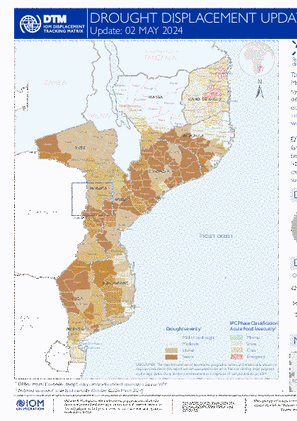
Contact
DTM Mozambique, DTMMozambique@iom.int
Language
English
Location
Mozambique
Period Covered
Apr 22 2024
Apr 24 2024
Activity
- Other
- Mobility Tracking
- Site Assessment
- Event Tracking
The Displacement Tracking Matrix (DTM), in collaboration with Mozambique’s National Institute for Disaster Management (INGD), conducted assessments in Maringue, Chemba, and Barue to record displacements caused by severe El Niño induced drought conditions. Mozambique's National Meteorological Institute (INAM) project decreased precipitation levels and drought conditions across districts in Central and Southern Mozambique - potentially impacting over 20 million people. El- Niño induced drought, land degradation and increased salinity in important water sources continue to place a strain on the agriculture, livestock herding and fishing industries, with many families unable to guarantee sufficient and sustainable livelihoods in rural areas.
DTM’s tracking of climate-induced displacement aims to provide data on the number and location of vulnerable families forced into displacement due to climatic and environmental factors. Joint assessments conducted between 22-24 April estimate 342 individuals (58 families) displaced from Northern Sofala and Tete districts to host communities of Manica (Barue district). Priority needs identified by IDPs include food security, access to clean water, adequate shelter, and agricultural inputs. Additionally, there is a pressing demand for non-food items such as hygiene kits, blankets, mosquito nets, and kitchen sets.
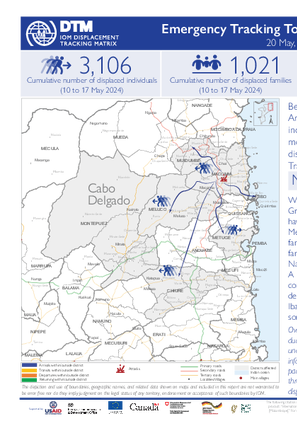
Contact
DTMMozambique@iom.int
Language
English
Location
Mozambique
Period Covered
May 10 2024
May 17 2024
Activity
- Mobility Tracking
- Event Tracking
Between 10 to 17 May 2024, attacks, and fear of attacks by Non-state Armed Groups in Macomia triggered the cumulative displacement of 3,106 individuals/ 1,021 families. The current Movement Alert #113 reports on most recent attacks in Northen Cabo Delgado. For more information on displacements between January and April, please see {Emergency Tracking Online Dashboard}.
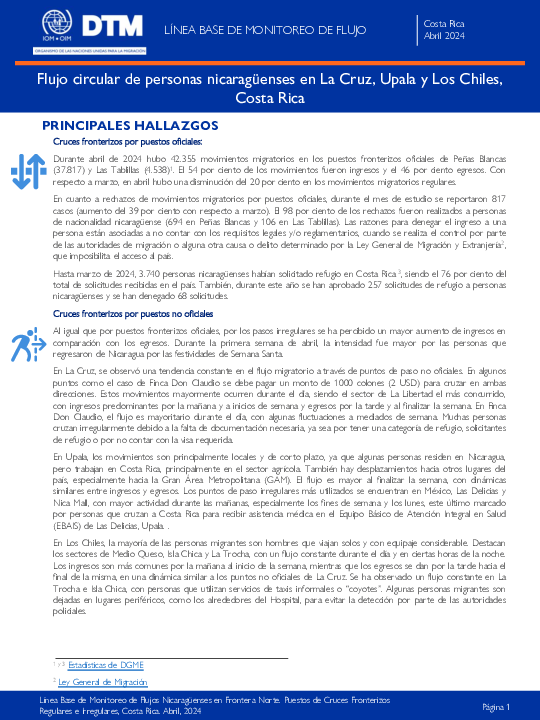
Contact
DTMCostaRica@iom.int
Language
English
Location
Costa Rica
Period Covered
Apr 01 2024
Apr 30 2024
Activity
- Flow Monitoring
- Baseline Assessment
La Organización Internacional para las Migraciones (OIM), como agencia de las Naciones Unidas en materia de migración en Costa Rica, implementó, desde 2021, dos rondas de la Matriz de Seguimiento al Desplazamiento (DTM por sus siglas en inglés) como parte de su estrategia de monitoreo del flujo migratorio circular de personas de nacionalidad nicaragüense, en puntos fronterizos no oficiales, en distintos cantones del norte del país. A partir de este ejercicio en tres puntos de ingreso no oficial de la frontera con Nicaragua, se contabilizaron 60 697 movimientos migratorios, de los cuales el 59 por ciento fueron egresos y 41 por ciento ingresos.
Siendo parte fundamental de la misión de OIM brindar asesoría clave sobre políticas y prácticas migratorias, se vuelve necesario actualizar los datos de este flujo migratorio circular de nicaragüenses que cruzan tanto de forma regular como irregular la frontera norte de Costa Rica.
Según los registros de la DGME de ingresos y egresos regulares por puestos fronterizos oficiales en Los Chiles y Peñas Blancas, en 2022 hubo 394.730 movimientos migratorios regulares (50 % ingresos y 50 % egresos) mientras que, durante el 2023, en total se registraron 526.271 movimientos migratorios (50 % ingresos y 50 % egresos), lo cual representó un aumento de 33 por ciento con respecto a 2022. Durante abril de 2024, se realizaron un total de 42.355 movimientos migratorios siendo el 54 por ciento egresos y el 46 por ciento egresos.
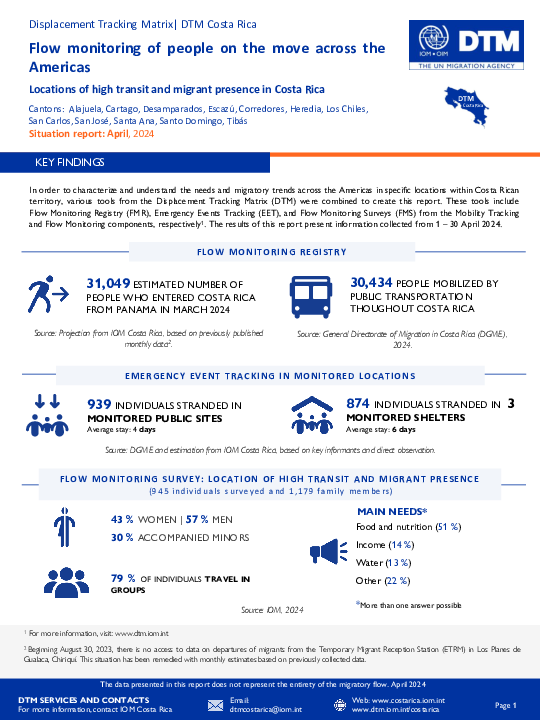
Contact
DTMCostaRica@iom.int
Language
English
Location
Costa Rica
Period Covered
Apr 01 2024
Apr 30 2024
Activity
- Flow Monitoring
- Mobility Tracking
- Event Tracking
Cantons: Alajuela, Alajuelita, Cartago, Desamparados, Escazú, Corredores, Heredia, Los Chiles, San Carlos, San José, Santa Ana, Santo Domingo, Tibás
Costa Rica, like the other countries in the Central American region, has been characterized as a migratory corridor for people who transit by land from the south to the north of America and whose destination is the countries in the north of the continent. This flow on the move through the Americas is mainly made up of people from the Bolivarian Republic of Venezuela, Cuba, Haiti, Ecuador, as well as people from other countries in South America, Africa and Asia.
According to estimations from IOM Costa Rica, during April 31,049 people entered the country, an approximate average of 1,035 people per day and estimating a decrease of 14% compared to March 2024. In addition, 874 people stranded in the monitored shelters were identified and 939 people stranded in the public places visited.

Contact
DTM Ukraine, dtmukraine@iom.int
Language
English
Location
Ukraine
Period Covered
Feb 01 2024
Mar 31 2024
Activity
- Other
За два роки повномасштабного вторгнення гуманітарна ситуація в Україні, зокрема поблизу лінії фронту, дедалі ускладнюється. У зв’язку з цим Відділ даних та аналітики Міжнародної організації з міграції (МОМ) розробив систему моніторингу населення прифронтових територій для відстежування мобільності та критичних потреб цивільного населення в місцевостях, що суттєво постраждали від конфлікту. Ця система включає три ключові компоненти: Оцінку мобільності та потреб (MaNA), моніторинг населених пунктів на прифронтових територіях і моніторинг потоків у зонах евакуації. MaNA містить інформацію про оцінену чисельність населення з дезагрегацією за статтю та віком на рівні громад, а також про оцінену частку населення, що має гострі гуманітарні потреби. Моніторинг населених пунктів на прифронтових територіях надає змогу отримувати деталізовані базові розрахункові показники населення, а також інформацію про основні гуманітарні потреби у вибраних населених пунктах, розташованих у межах 25 км від лінії фронту, для ефективнішого розроблення сценаріїв та попереднього планування гуманітарної допомоги. Крім того, МОМ постійно відстежує динаміку переміщень, щоб надавати гуманітарним партнерам дані про напрями й масштаб переміщень із вибраних населених пунктів, де проходить евакуація. Кожен із цих компонентів спрямований на підтримку координації дієвого гуманітарного реагування, забезпечення безпеки та добробуту постраждалого населення прифронтових територій.
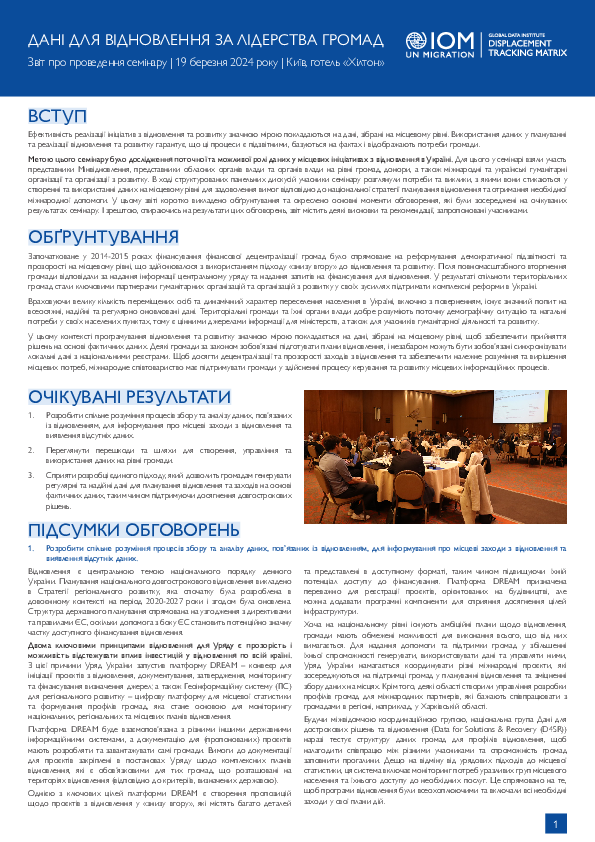
Contact
DTM Ukraine, dtmukraine@iom.int
Language
English
Location
Ukraine
Snapshot Date
Mar 19 2024
Activity
- Other
Ефективні ініціативи з відновлення та розвитку значною мірою спираються на дані, зібрані на місцевому рівні. Використання даних у плануванні та реалізації заходів з відновлення та розвитку гарантує, що ці процеси будуть підзвітними, фактологічно обґрунтованими та відображатимуть потреби громади.
Цей семінар мав на меті дослідити поточну та можливу роль даних у місцевих ініціативах з відновлення в Україні. Для цього в семінарі взяли участь представники Міністерства з питань відновлення, обласної та місцевої влади, донори, а також міжнародні та українські гуманітарні організації та організації, що займаються питаннями розвитку. Під час серії структурованих панельних дискусій учасники семінару розглянули потреби та виклики, з якими стикаються при створенні та використанні даних на місцевому рівні, щоб задовольнити вимоги відповідно до національної стратегії планування відновлення та залучити необхідну міжнародну допомогу.
У цьому звіті узагальнено обґрунтування та викладено основні моменти дискусій, які були зосереджені на очікуваних результатах семінару. Нарешті, на основі цих обговорень у звіті представлені деякі висновки та рекомендації, запропоновані учасниками.
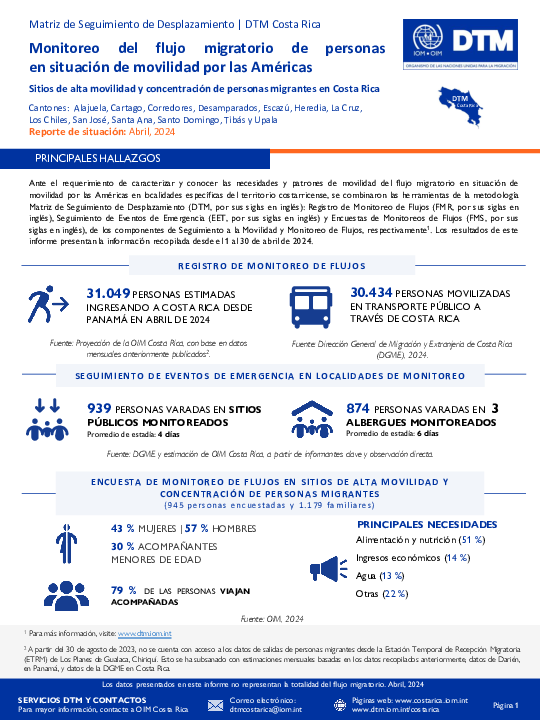
Contact
Angélica Madrigal amadrigal@iom.int
Language
English
Location
Costa Rica
Period Covered
Apr 01 2024
Apr 30 2024
Activity
- Survey
- Registration
- Flow Monitoring
Cantones: Alajuela, Alajuelita, Cartago, Desamparados, Escazú, Corredores, Heredia, Los Chiles, San Carlos, San José, Santa Ana, Santo Domingo, Tibás
Costa Rica, al igual que los demás países de la región centroamericana, se ha caracterizado por ser un corredor migratorio para personas que transitan de manera terrestre desde el sur hasta el norte de América y que tienen como destino los países del norte del continente. Este flujo en situación de movilidad por las Américas se encuentra compuesto principalmente por personas de la República Bolivariana de Venezuela, Cuba, Haití, Ecuador, así como personas provenientes de otros países de Suramérica, África y Asia.
Según estimaciones de la OIM Costa Rica, durante abril ingresaron al país 31.049 personas, un promedio aproximado de 1.035 personas por día y estimando una disminución de un 14% con respecto a marzo de 2024. Además, se identificaron 874 personas varadas en los albergues monitoreados y 939 personas varadas en los sitios públicos visitados.
Pagination
- Previous page
- Page 7
- Next page
